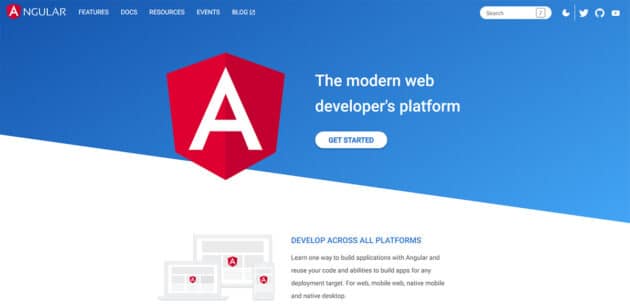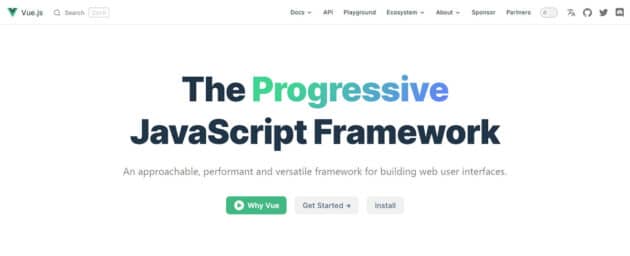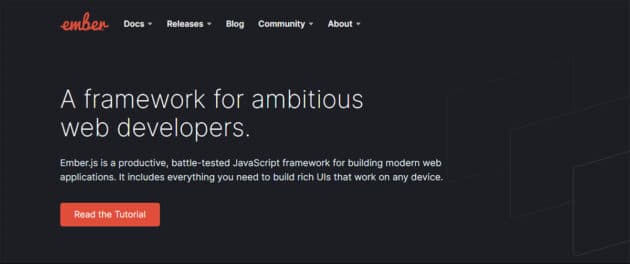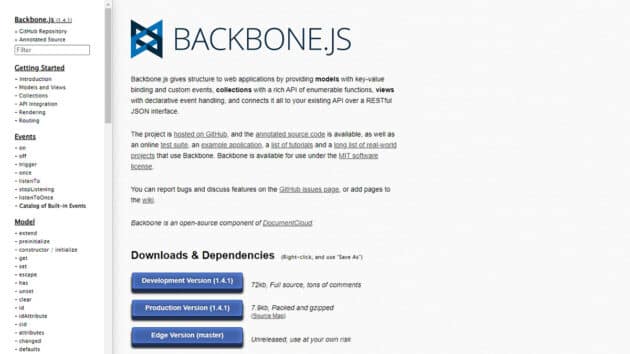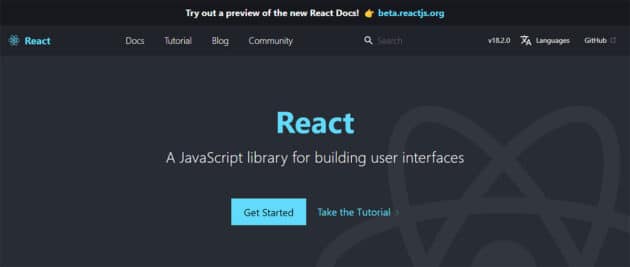The front-end part of a site plays a major role in the website’s success. A compelling and user-friendly interface attracts users and enhances user engagement on your website. Unarguably, web developers worldwide are making use of various front-end development frameworks to build websites with excellent user experience. It is even essential to render a great user experience to retain your customers in the long run.
An abundance of front-end web development frameworks, like Angular, Vue.js, etc., are available in the market. You will always find such frameworks in the technology stack of a leading web development company.
Choosing a perfect one among various options could be difficult as each framework comes with its own set of benefits and limitations.
Factors affecting the selection of a front-end framework

Let’s take a look at the factors that often affect the selection of a suitable front-end framework for website or web application development.
Recommended for you: 5 Good Reasons to Pick Laravel for a Web Development Project.
Popularity
One major factor is to know how much the framework is used for web development. It shows the power of the corresponding front-end development framework.
Features
Another major factor is the unique features that a framework offers to ease the web development process. You must ensure that your chosen framework includes the kind of features you require for your web development project.
Flexibility
It is good to choose the framework that comes with a lot of customization options, which is helpful in developing the website or web application as per your specific needs.
Integration capabilities
Though a framework can be powerful and flexible, there might be the possibility of integrating additional tools and libraries. So, you must ensure that the chosen framework facilitates an easy integration process for third-party tools and libraries.
Project size and type
Choosing the right framework also depends on the size and type of your web development project. The goal of a small website or web application with limited functionalities can be achieved by a basic framework. Also, if you intend to build a large-scale enterprise-level web application, you will require a more flexible tool to serve your purpose.
By keeping these mentioned considerations in mind, you will be able to determine the suitable front-end framework that best suits your business and project needs.
Top frameworks used for front-end web development

Now, let’s move toward the list of top frameworks used for creating the best front ends for websites or web applications. Read on to find the top front-end frameworks suitable for creating an engaging and user-friendly front-end of a website or web application.
1. Angular
As we are talking about the best front-end frameworks, Angular will be at the top of the list. The list of top front-end web development frameworks is incomplete without discussing Angular.
Angular is a JavaScript-based framework used to develop efficient and scalable single-page applications (SPAs). To create an enticing front-end for your website, investing in Angular development services will be highly beneficial.
Benefits of Using Angular
- Angular offers two-way data binding between the model and the view. Due to this, any alteration in the model will immediately reflect in the view and vice versa, leading to a faster web development process.
- The code of Angular is unit testable.
- Angular offers reusable components.
- Angular lets developers achieve more functionality with less code.
- One major benefit of Angular is that Angular-based web apps can execute on all major browsers and different devices like smartphones, tablets, and others.
When to Use Angular
It is best to use Angular for an enticing front-end web development. Various major brands like Upwork, JetBlue, Freelancer, and others have used this JavaScript framework for website development.
You can look at our Angular web development guide for a lot more information about this JavaScript framework.
2. Vue.js
Another major front-end framework on the list is the Vue.js framework. It is a lightweight JavaScript-based framework that is easy to install and enables you to develop the website in a matter of minutes.
You can opt Vue.js framework for developing dynamic web applications, complex web apps, progressive web apps, and others. In comparison to Angular, Vue.js is an easy-to-use web development framework. This component-based framework offers various benefits, like virtual DOM and two-way data binding.
Benefits of Using Vue.js
- Vue.js also follows the component-based architecture, meaning the code can be divided into independent components.
- Vue.js is a lightweight JS framework and one of the fastest frameworks available for creating user interfaces (UIs).
- Vue.js uses the virtual DOM concept. It facilitates the easy rendering of DOM objects without refreshing and altering the entire tree every time.
When to Use Vue.js
You can invest in Vue.js development services to build dynamic web applications, progressive web applications, and complex websites and web apps with a scalable architecture.
You may like: 15 Good Reasons to Use Python in Web Development.
3. Ember.js
Ember.js is relatively new yet used for developing complex websites and web applications. It is a component-based front-end web development framework that comes with two-way data binding like Angular. It has many benefits, like a rich user interface (UI).
Ember.js follows the Model-View-ViewModel (MVVM) architecture that lets developers build highly functional and interactive websites and web applications. It is well-suited for long-term projects, single-page applications (SPAs), etc.
Benefits of Using Ember.js
- It offers high performance.
- The command line interface (CLI) of Ember.js lets you interface with the operating system of your machine.
- It comes with proper documentation.
When to Use Ember.js
You can consider the Ember.js framework if you want to develop platforms like LinkedIn with a user-friendly front-end.
You can rely on Ember.js to develop complex websites or web applications. It is a complete front-end development solution for large-scale projects.
However, one of its shortcomings is its steeper learning curve. Because of its rigid and conventional structure, it ends up as the toughest framework to learn.
4. Backbone.js
It is one of the easy-to-use JavaScript frameworks for front-end development. Backbone.js is based on the MVC (model view controller) architecture and lets you quickly create SPAs.
It offers features to simplify the web application development and single-page development (SPA) process.
Benefits of Backbone.js
- Backbone.js is another lightweight JS-based front-end framework.
- It is versatile and uses the underscore.js library. So, you do not have to rely on jQuery.
- Backbone.js comes with various guides and documentation making it easy to learn and understand.
When to Use Backbone.js
You can use the Backbone.js framework for creating dynamic web applications like Trello. It is ideal for developing web apps that require dynamic handling of updates, continuous server synchronization, etc.
The downside of using Backbone.js is it offers a minimal prerequisite for developing a web app. However, it is possible to expand the functionalities using extensions and plugins. If you are looking for a complete dynamic solution in a single framework, you should not consider Backbone.js.
5. React.js
The discussion will be incomplete without React.js. It is a widely used JavaScript library that stands apart on the list of major front-end development tools. It is an open-source and effective JS library that helps developer to create interactive user interfaces (UIs) for complex websites or web applications.
React.js comes with the virtual DOM concept, which is a lightweight and virtual representation of the actual DOM. It prevents updating the entire tree structure every time, saving the process of repeatedly re-rendering the DOM and thus reducing the browser load. It boosts the overall performance of a ReactJS-based website or web application.
Benefits of Using ReactJS
- ReactJS lets developers create reusable components that can be used in the various parts of the website or web app.
- ReactJS also makes it possible to create interactive and engaging user interfaces for websites or web applications.
- It follows the uni-directional data flow that is beneficial in debugging the web application and helps to make it less error-prone.
- It comes with extensive community support that helps you or even a React.js web development company cope with the incoming web development challenges.
Use Cases of ReactJS
- It is good to use the React.js library for creating websites and web applications with many components.
- You can consider ReactJS for developing dynamic web development solutions.
- It offers excellent functionalities that make it suitable for developing complex front ends and UIs for web applications.
You may also like: Top 5 Web Development Technologies in Spotlight in 2022-2023.
Conclusion

So, these were the major front-end development frameworks that are helpful for developing top-notch and complex front ends for websites or web applications. All the above-mentioned frameworks are based on JavaScript. Among them, Angular, ReactJS, and Vue.js have attained higher positions in the market.
Moreover, if we talk about choosing a suitable framework, it widely depends on your project requirements. As all such tools come with their benefits and limitations, it is not easy to pick one.
Therefore, you must curate a list of your specific needs and match them with the features of the framework. It will help you to decide which one is well-suited to you for website or web application development.
If the dilemma still exists, look for the usage and statistics. It will also be better to get qualified assistance from a professional of a web development company.
This article is written by Johnson Lewis. Johnson is a web developer in HTMLPanda - a leading web development company. He loves to read about learning new technologies and sharing information on the internet by writing articles and blogs.
